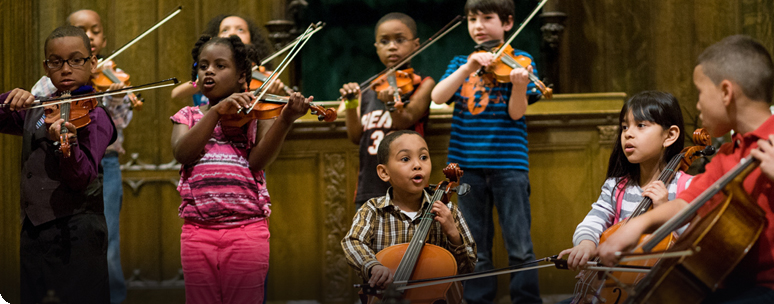Knock, knock. (It’s Philip Glass)Knock, knock. Who’s there? Knock, knock. Who’s there? Knock, knock. Who’s there? Philip Glass. That’s how the old joke goes. To some, Philip Glass is merely a gimmick. After the opening performance of Glass’ Akhnaten in its 1984 run at the New York City Opera, New York Times critic Donal Henahan wrote, “[Glass’ operas] stand to music as the sentence ‘See Spot Run’ stands to literature.” To others, Glass’ music has a mesmerizing beauty. Mr. Henahan’s colleague at The New York Times, Robert Palmer, wrote: “One listens to the music and, somehow, without quite knowing it, one crosses the line from being puzzled or irritated to being absolutely bewitched. The experience is inexplicable but utterly satisfying and one could not ask for anything more than that.” At CMW, we had the privilege of having his String Quartet No. 5 in our lives this spring thanks to the dedicated work of the CMW Fellows Quartet. Because of this piece, I now stand resolutely and proudly with Mr. Palmer. The term “minimalism” makes some classical music fans groan. Even some “minimalist” composers shudder at the word. In a nutshell, the term refers to a repeating cell (basic unit) of melody or rhythm that evolves over time because of rhythmic and/or melodic transformation. The first examples of minimalism in music date from the 1960s with the work of Terry Riley and Steve Reich on the West Coast. Philip Glass began experimenting in a minimalist style during his studies in Paris. From 1964-66, Glass studied composition and form on a Fulbright grant with the French composer and pedagogue, Nadia Boulanger. To pick up extra cash, he worked for Ravi Shankar, transcribing music for a score Shankar was composing for the American film, Chappaqua. The repeating rhythmic and melodic patterns entranced Glass, who had never before heard Indian music. In 1965, Glass wrote music for a staging of Samuel Beckett’s Play, using two saxophones that repeated the same two notes over and over, but in different meters—a variant of the “phase” technique introduced by Steve Reich. He would never look back. He returned to New York City in 1967 and formed the Philip Glass Ensemble the following year as an outlet for his cyclical compositions. Initially, the Ensemble performed mostly in loft spaces and galleries, and Glass had to supplement his income by working as a mover, a plumber and as a cab driver. Over time, his audience continued to grow and in 1976, he experienced one of his first global successes with the plot-less opera, Einstein on the Beach. While he had already been legitimized by the pop world with glowing endorsements from Brian Eno and David Bowie, the classical art world began to take notice as well. Commissions and projects in a variety of genres and media poured in, and in 1978, he could finally retire from non-musical jobs and devote himself full time to his craft. Today he is one of the most powerful and influential people in the arts, and one of the most global names in classical music. In conversation with Los Angeles Times critic and writer, Mark Swed, Glass describes the string quartet as a genre representing a spiritual and personal checkpoint for composers. “In an odd way, string quartets have always functioned like that for composers. I don’t really know why, but it’s almost impossible to get away from it. It’s the way composers of the past have thought and that’s no less true for me.” When he set about to write his Fifth Quartet (actually his eighth foray into the genre, as his first three attempts were discarded works from his youth), he was unfettered by the need to write a “serious” work of art. “I was thinking that I had really gone beyond the need to write a serious string quartet and that I could write a quartet that is about musicality, which in a certain way is the most serious subject.” Completed in 1991 and written in five continuous movements, the work opens with a centering, bell-like pizzicato followed by warm, radiant incantations. The first movement is essentially a prelude or a call to worship. The second movement has a feeling of inevitability, with an ostinato rocking bass in the cello propelling an excited syncopated melody above. The third movement announces itself with an energetic, dancing fanfare. It is not difficult to imagine a group of revelers lifting their hands up in a joyous dance of life. Like the slow movement of a Bruckner symphony, long melodic lines, propelled by ostinato arpeggiations and the familiar rocking motion of the second movement, swell to peaks and acquiesce to valleys in a beautiful, slowly paced fourth movement. The final movement opens with repeating, pentatonic shimmers a la the French composer Maurice Ravel. Gradually, a rhythmic groove emerges from the watery texture, which transforms into frenetic scales racing up and down the ladder. A reprise of the quartet’s introduction is then heard before it merges with the quicksilver scalar passages. A controlled hoedown follows before we hear the work’s introduction one final time accompanied by pizzicato echoes of the rocking motor from the second movement. -Jesse Holstein, Providence String Quartet |
